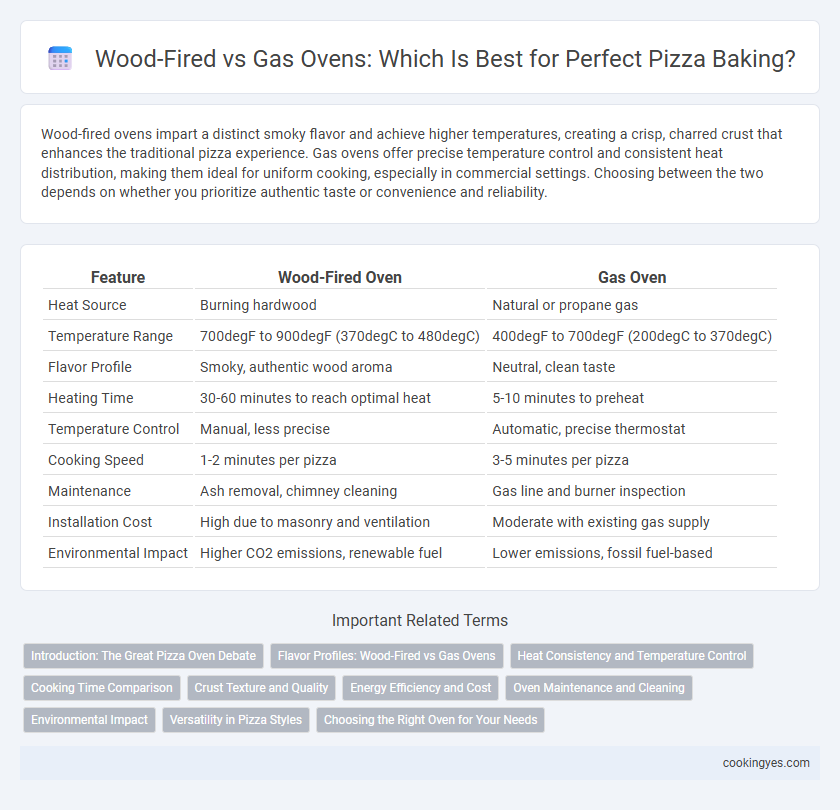Wood-fired ovens impart a distinct smoky flavor and achieve higher temperatures, creating a crisp, charred crust that enhances the traditional pizza experience. Gas ovens offer precise temperature control and consistent heat distribution, making them ideal for uniform cooking, especially in commercial settings. Choosing between the two depends on whether you prioritize authentic taste or convenience and reliability.
Table of Comparison
| Feature | Wood-Fired Oven | Gas Oven |
|---|---|---|
| Heat Source | Burning hardwood | Natural or propane gas |
| Temperature Range | 700degF to 900degF (370degC to 480degC) | 400degF to 700degF (200degC to 370degC) |
| Flavor Profile | Smoky, authentic wood aroma | Neutral, clean taste |
| Heating Time | 30-60 minutes to reach optimal heat | 5-10 minutes to preheat |
| Temperature Control | Manual, less precise | Automatic, precise thermostat |
| Cooking Speed | 1-2 minutes per pizza | 3-5 minutes per pizza |
| Maintenance | Ash removal, chimney cleaning | Gas line and burner inspection |
| Installation Cost | High due to masonry and ventilation | Moderate with existing gas supply |
| Environmental Impact | Higher CO2 emissions, renewable fuel | Lower emissions, fossil fuel-based |
Introduction: The Great Pizza Oven Debate
Wood-fired and gas ovens each offer distinct advantages for pizza baking, impacting crust texture and flavor profile significantly. Wood-fired ovens typically reach higher temperatures, around 800-900degF, creating a characteristic smoky flavor and perfectly charred crust. Gas ovens provide more consistent heat control, allowing for uniform baking and ease of use, making them a popular choice for busy pizza kitchens.
Flavor Profiles: Wood-Fired vs Gas Ovens
Wood-fired ovens impart a smoky, charred flavor to pizza that enhances the complexity and depth of the crust and toppings. Gas ovens provide a more consistent and controllable heat, producing a cleaner, more neutral taste that highlights the natural flavors of fresh ingredients. The distinct smoky aroma from wood-fired baking often results in a richer, more traditional pizza experience compared to the milder profile of gas oven pizzas.
Heat Consistency and Temperature Control
Wood-fired ovens offer intense heat with natural wood smoke, but achieving consistent temperature control can be challenging due to fluctuating fuel and airflow. Gas ovens provide precise temperature regulation and stable heat distribution, allowing for more consistent baking results and reduced cooking times. Professional pizzerias often prefer gas ovens for their reliability, while wood-fired ovens are favored for their unique flavor imparted by high, variable heat.
Cooking Time Comparison
Wood-fired ovens typically reach temperatures between 700degF and 900degF, enabling pizzas to cook in just 90 seconds to 2 minutes, producing a crispy crust and smoky flavor. Gas ovens usually maintain lower temperatures around 500degF to 600degF, resulting in longer cooking times of 5 to 7 minutes but offering more consistent heat control. The faster cooking time in wood-fired ovens enhances the char and texture, while gas ovens provide uniform baking suitable for high-volume production.
Crust Texture and Quality
Wood-fired ovens produce a distinctive pizza crust characterized by a smoky aroma, blistered char, and a perfectly crisp exterior with a chewy interior due to the intense, uneven heat. Gas ovens offer more consistent temperature control, resulting in an even bake and uniform crust texture but typically lack the unique flavor profile and slight charring that wood-fired ovens impart. The choice between wood-fired and gas ovens significantly influences crust quality, balancing artisan taste and traditional texture versus reliable consistency.
Energy Efficiency and Cost
Wood-fired ovens consume more energy due to extended heating times and high fuel requirements, leading to increased operational costs compared to gas ovens. Gas ovens provide better energy efficiency by delivering consistent heat quickly, reducing fuel consumption and lowering expenses. Initial investment in wood-fired ovens is often higher, while gas ovens typically offer more affordable installation and maintenance costs.
Oven Maintenance and Cleaning
Wood-fired ovens require frequent ash removal and regular inspection to prevent buildup of creosote and soot, demanding consistent cleaning to maintain optimal heat and flavor. Gas ovens offer easier maintenance with fewer residues, requiring periodic cleaning of burners and drip trays to prevent clogging and ensure efficient operation. Choosing between these ovens depends on balancing the rustic flavor benefits of wood-fired ovens against the convenience and low-maintenance advantages of gas ovens.
Environmental Impact
Wood-fired ovens emit higher levels of particulate matter and carbon dioxide due to the combustion of natural wood, contributing to deforestation and air pollution. Gas ovens produce fewer emissions and offer more precise temperature control, resulting in lower environmental impact and improved energy efficiency. Choosing gas ovens supports sustainable practices by reducing greenhouse gas emissions and minimizing resource consumption during pizza baking.
Versatility in Pizza Styles
Wood-fired ovens excel in producing traditional Neapolitan-style pizzas with a uniquely charred crust and smoky flavor, lending authenticity to classic recipes. Gas ovens offer greater versatility, enabling consistent temperature control suited for a wide range of pizza styles, including thin-crust, deep-dish, and stuffed crust varieties. Chefs seeking diverse menu options often prefer gas ovens for reliable, even baking across multiple pizza styles.
Choosing the Right Oven for Your Needs
Wood-fired ovens provide high, consistent heat that creates a distinctive smoky flavor and crispy crust ideal for traditional Neapolitan pizza, while gas ovens offer precise temperature control and faster heating, making them more convenient for busy pizzerias or home use. Consider factors such as desired flavor profile, cooking time, kitchen space, and fuel availability when choosing between wood-fired and gas ovens for pizza baking. Opting for a wood-fired oven emphasizes authentic taste and artisanal quality, whereas gas ovens prioritize efficiency and ease of operation.
Wood-fired vs Gas oven for pizza baking Infographic

 cookingyes.com
cookingyes.com